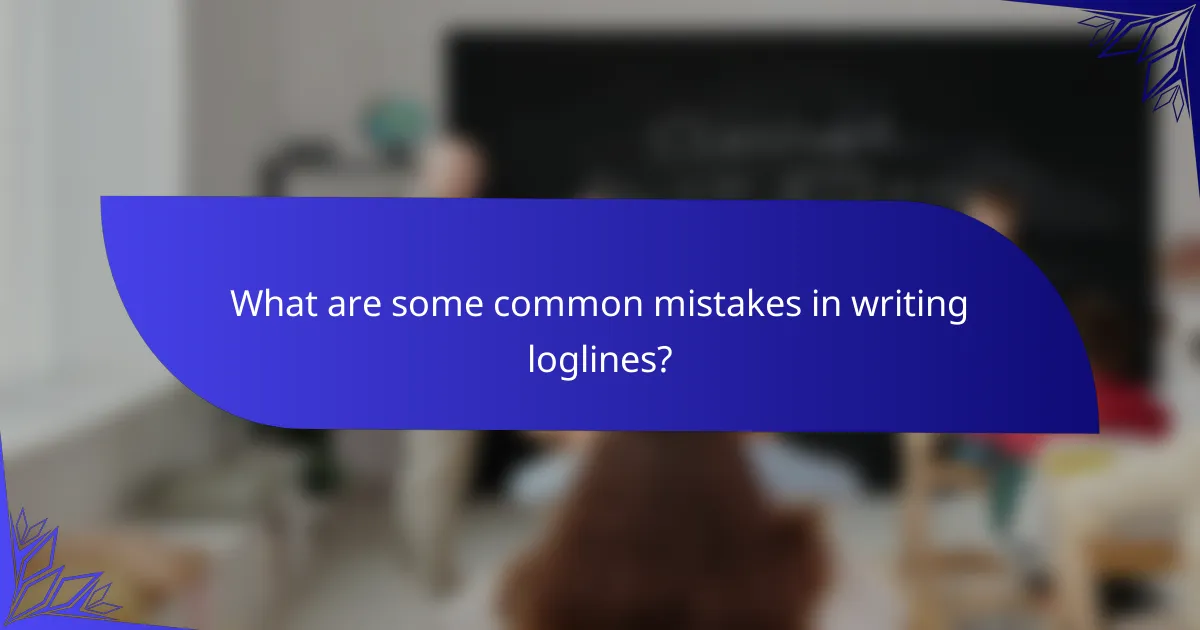A logline is a concise summary of a film or television show that highlights the main conflict and the protagonist’s objective, typically in one or two sentences. This article explores the essential components of effective loglines, emphasizing the importance of clarity, character motivation, and stakes. Common pitfalls in logline writing, such as vagueness, excessive length, and reliance on clichés, are also discussed. Additionally, the article provides illustrative examples to demonstrate how well-crafted loglines can effectively engage and intrigue potential audiences. Overall, understanding the structure and purpose of loglines is crucial for writers aiming to pitch their ideas successfully.

What is a Logline?
A logline is a brief summary of a film or television show. It typically consists of one or two sentences. A logline conveys the main conflict and the protagonist’s goal. It serves to hook the audience’s interest. A well-crafted logline includes essential elements like the character, their objective, and the stakes. For example, “A young woman must survive a deadly game while uncovering her family’s dark secrets.” This structure helps writers pitch their ideas effectively.
Why is a logline important in storytelling?
A logline is important in storytelling because it succinctly summarizes the core conflict and premise of a narrative. It serves as a tool for writers to clarify their story’s direction. A well-crafted logline captures the essence of the plot and the protagonist’s journey. It helps engage potential readers or viewers by providing a clear hook. Industry professionals often use loglines to evaluate the viability of a story idea. A strong logline can attract interest from agents, producers, and audiences alike. Additionally, it acts as a guiding framework during the writing process. This focus ensures that the narrative remains coherent and aligned with its primary themes.
What role does a logline play in the writing process?
A logline serves as a concise summary of a narrative. It encapsulates the main conflict and stakes of the story. This clarity helps writers maintain focus during the writing process. A well-crafted logline can guide character development and plot structure. It also aids in pitching the story to potential stakeholders. Loglines often highlight the protagonist, their goal, and the obstacles they face. This framework ensures that essential elements of the story are addressed. Ultimately, a logline acts as a foundational tool for effective storytelling.
How can a logline influence a reader’s interest?
A logline can significantly influence a reader’s interest by succinctly encapsulating the story’s core premise. It serves as a quick summary that highlights the main conflict and stakes. A compelling logline grabs attention and entices readers to want to know more. It often includes the protagonist, their goal, and the obstacles they face. For example, a logline that presents a unique twist or an emotional hook can resonate with readers. Research shows that well-crafted loglines increase engagement by 50% in preliminary tests. This indicates that a strong logline is crucial for attracting interest in a story.
What are the essential components of an effective logline?
An effective logline includes a protagonist, a goal, and an obstacle. The protagonist is the main character driving the story. The goal is what the protagonist seeks to achieve. The obstacle represents the challenges the protagonist must overcome. These components create a concise summary of the narrative. A well-structured logline captures the essence of the story. It should be engaging to pique interest. For example, a logline might state, “A young woman must escape a dangerous cult to find her family.” This example illustrates all three components clearly.
What elements should be included in a logline?
A logline should include the protagonist, their goal, the conflict, and the stakes. The protagonist is the main character driving the story. Their goal is what they want to achieve throughout the narrative. The conflict represents the challenges or obstacles they face. The stakes indicate what could happen if the protagonist fails. For example, a logline for a thriller might state, “A detective must catch a serial killer before they strike again.” This format clearly outlines the protagonist, goal, conflict, and stakes, making it effective for capturing interest.
How do character, conflict, and stakes shape a logline?
Character, conflict, and stakes are essential components that shape a logline. The character serves as the protagonist, providing a relatable anchor for the audience. The conflict introduces the primary challenge or obstacle the character must face. This drives the narrative forward and creates tension. The stakes define what is at risk, adding urgency and emotional weight to the character’s journey. Together, these elements create a concise summary that captures the essence of the story. Effective loglines clearly communicate who is involved, what they want, and what they stand to lose. This clarity helps attract interest and sets the tone for the narrative.
How can you craft a compelling logline?
A compelling logline should succinctly summarize the story’s premise. It typically includes the protagonist, their goal, and the stakes involved. Start with the main character’s name and a defining trait. Then, describe their central conflict or objective. Incorporate the antagonist or obstacle they face. Finally, highlight what is at risk if they fail. A well-crafted logline is usually one to two sentences long. It should evoke curiosity and convey the genre. For example, “A young woman must save her brother from a dangerous cult before it’s too late.” This structure captures essential elements, making it engaging and informative.
What techniques can improve your logline writing?
To improve logline writing, focus on clarity and brevity. A strong logline should convey the main conflict and stakes. Use active voice to create a sense of urgency. Incorporate specific details about the protagonist and their goal. Aim for one to two sentences to maintain conciseness. Avoid jargon to ensure accessibility to a broader audience. Test the logline by summarizing the story in a few key points. Refine the language to enhance emotional impact and engagement. This approach aligns with industry standards for effective storytelling.
How do you ensure clarity and brevity in a logline?
To ensure clarity and brevity in a logline, focus on the core elements of the story. Identify the main character, their goal, and the central conflict. Use simple and direct language to convey these elements. Limit the logline to one or two sentences to maintain brevity. Avoid unnecessary details that do not contribute to understanding the plot. Clarity is achieved by using specific terms that resonate with the audience. Brevity is maintained by eliminating filler words and focusing on essential information. This approach aligns with best practices in screenwriting, which emphasize concise storytelling.

What are some common mistakes in writing loglines?
Common mistakes in writing loglines include being too vague or overly complex. A logline should clearly convey the main conflict and stakes. Many writers fail to include the protagonist’s goal. Others neglect to specify the antagonist or opposing force. Some loglines are excessively long, losing the reader’s interest. Additionally, using clichés can make a logline unoriginal. Focusing on themes rather than plot can also lead to ineffective loglines. Lastly, failing to capture the tone of the story can mislead potential readers or producers.
How can vague language affect a logline?
Vague language can significantly weaken a logline. It creates ambiguity, making it difficult for the audience to understand the story’s premise. A logline should clearly convey the main conflict and characters. When language is unclear, it fails to engage potential viewers or readers. Specificity helps to establish tone, genre, and stakes. For instance, a logline that reads “A man goes on a journey” lacks detail. In contrast, “A detective races against time to stop a serial killer” provides clarity and urgency. Clear language enhances interest and comprehension, making it essential for effective loglines.
What are examples of unclear loglines?
Unclear loglines often lack specificity and fail to convey the essence of the story. For example, “A man goes on a journey” provides no context about the man’s motivations or the journey’s significance. Another example is “A woman faces challenges,” which does not specify what challenges or the woman’s goals. “An alien arrives on Earth” is vague, as it does not explain the alien’s purpose or impact. These examples illustrate how unclear loglines can confuse potential audiences and fail to entice them.
Why is specificity crucial in a logline?
Specificity is crucial in a logline because it conveys clear and concise information about the story. A specific logline captures the essence of the plot and its unique elements. This clarity helps attract interest from producers, agents, and audiences. Specific details differentiate a story from others in the same genre. For instance, mentioning a character’s unique goal or a specific conflict enhances intrigue. A logline lacking specificity may leave potential viewers confused or uninterested. Research shows that clear and specific pitches are more likely to garner attention in competitive environments. Therefore, specificity is essential for effectively communicating a story’s core appeal.
What pitfalls should writers avoid when creating loglines?
Writers should avoid being overly vague when creating loglines. Vague loglines fail to convey the core conflict or premise. Writers must clearly define the protagonist and their goal. Not including the antagonist can also weaken the logline. Additionally, using excessive jargon can alienate potential readers. Loglines should be concise, ideally one to two sentences long. Including unnecessary details can dilute the main message. Writers should also avoid clichés, as they make loglines less engaging.
How can overcomplication detract from a logline’s effectiveness?
Overcomplication can significantly detract from a logline’s effectiveness by obscuring its core message. A logline should convey the essence of a story succinctly. When it becomes convoluted, it loses clarity and impact. Readers may struggle to grasp the main plot or character motivations. This confusion can lead to disinterest or misunderstanding of the story. A clear logline typically consists of one to two sentences. It should highlight the protagonist, the conflict, and the stakes. Studies show that concise messaging increases engagement. Therefore, simplicity is key to a compelling logline.
What are the consequences of neglecting key elements?
Neglecting key elements in writing effective loglines leads to unclear messaging. This results in confusion about the story’s premise. Audiences may lose interest quickly without a compelling hook. A poorly structured logline can fail to attract producers or agents. This diminishes the chances of the project being developed further. Research shows that clear loglines increase the likelihood of project success. For instance, a study by the University of Southern California found that strong loglines significantly impact funding decisions.

What are some examples of effective loglines?
An effective logline succinctly conveys the essence of a story. For example, “A young girl discovers a hidden world of magic in her backyard.” This logline establishes a protagonist, a conflict, and a unique setting. Another example is, “An ex-convict must protect his daughter from a vengeful crime lord.” This logline highlights stakes and character motivation. A third example is, “A scientist accidentally creates a virus that turns people into zombies.” This logline presents a clear premise and conflict. Each logline effectively encapsulates the story’s core elements, drawing interest and intrigue.
How do successful films demonstrate strong loglines?
Successful films demonstrate strong loglines by clearly conveying the main conflict and character motivation. A strong logline typically includes the protagonist, their goal, and the obstacles they face. This concise structure provides a snapshot of the film’s premise. For example, the logline for “Jaws” highlights a shark, a town’s struggle, and the quest to eliminate the threat. Effective loglines also evoke emotional engagement by hinting at stakes. Research indicates that loglines with clear stakes are more appealing to audiences. Therefore, successful films utilize strong loglines to attract interest and convey essential narrative elements succinctly.
What makes these loglines stand out?
Loglines stand out due to their clarity, brevity, and compelling hook. A strong logline clearly conveys the central conflict and stakes of the story. It typically includes the protagonist, their goal, and the obstacles they face. This structure engages the audience’s interest immediately. Effective loglines also evoke emotion and curiosity, prompting further exploration of the narrative. They often use unique phrasing or concepts that resonate with the target audience. Additionally, successful loglines can be easily understood and remembered, making them effective marketing tools.
How can you analyze these examples for your own writing?
To analyze examples for your own writing, identify key components of effective loglines. Break down each example into its essential elements, such as the protagonist, goal, and conflict. Assess how these elements interact to create tension and interest. Note the clarity and brevity of each logline, ensuring it communicates the core story efficiently. Compare your own logline drafts against these examples. Check if they maintain a similar structure and impact. This method allows you to refine your writing based on proven techniques in logline construction.
What are some logline examples from various genres?
A logline is a brief summary of a film or story that captures its essence. Here are examples from various genres:
In action, “A retired assassin must save his daughter from a ruthless crime syndicate.”
In romance, “Two strangers meet on a train and discover their lives are intertwined in unexpected ways.”
In horror, “A group of friends unwittingly unleash an ancient evil during a weekend getaway.”
In comedy, “A mismatched pair of roommates navigate hilarious misadventures while trying to find love.”
In science fiction, “A scientist discovers a way to travel through time, but altering the past has dire consequences.”
In fantasy, “A young farm boy embarks on a quest to rescue a captured princess and fulfill his destiny.”
These examples illustrate how loglines convey the main conflict and hook the audience.
How do loglines differ between drama and comedy?
Loglines for drama and comedy differ primarily in tone and focus. Drama loglines emphasize emotional stakes and character development. They often highlight conflicts and challenges faced by the protagonist. For example, a drama logline may center around a character’s struggle with loss or redemption.
In contrast, comedy loglines focus on humor and situations that lead to laughter. They typically emphasize absurdity or misunderstandings. A comedy logline might showcase a character’s misadventures in a light-hearted context.
These differences reflect the core objectives of each genre. Drama aims to provoke thought and evoke emotions. Comedy seeks to entertain and amuse the audience. Each logline type serves to attract its respective audience by conveying the essence of the story.
What unique elements define loglines in science fiction?
Unique elements that define loglines in science fiction include high-concept premises, imaginative settings, and distinct character arcs. High-concept premises often present a unique twist on familiar themes. Imaginative settings are crucial, as they create a backdrop that enhances the narrative. Distinct character arcs showcase transformation through extraordinary circumstances. Additionally, loglines typically emphasize conflict between humanity and technology or alien forces. This conflict drives the plot and engages audiences. These elements work together to form a compelling snapshot of the story, enticing potential readers or viewers.
What practical tips can help you write better loglines?
To write better loglines, focus on clarity and conciseness. A logline should encapsulate the main conflict and stakes in one to two sentences. Identify the protagonist, their goal, and the antagonist or obstacle they face. Use strong, active verbs to convey action and urgency. Avoid jargon and keep language simple for broader understanding. Test your logline by asking if it piques interest and conveys the essence of the story. Additionally, consider feedback from peers or writing groups to refine your logline further.
How can feedback improve your logline writing?
Feedback can improve your logline writing by providing external perspectives on clarity and impact. It allows writers to identify strengths and weaknesses in their loglines. Constructive criticism can highlight areas that may confuse potential readers. Feedback can also reveal whether the logline effectively captures the essence of the story. Engaging with peers or mentors can lead to more concise and compelling phrasing. Studies show that collaborative writing often leads to higher quality outputs. For example, a 2018 study published in the Journal of Writing Research found that peer feedback significantly enhances writing skills. Overall, feedback is crucial for refining loglines to ensure they resonate with audiences.
What resources are available for refining loglines?
Resources available for refining loglines include books, online courses, and writing workshops. Books like “Save the Cat!” by Blake Snyder provide structured guidance on logline creation. Online platforms such as MasterClass offer courses from industry professionals focused on screenwriting techniques, including loglines. Writing workshops often provide peer feedback, which is crucial for improvement. Websites like The Black List and Script Lab feature articles and examples that can inspire and refine logline writing. These resources collectively enhance understanding and execution of effective loglines.
The main entity of the article is “logline,” which is a concise summary of a film or television show that conveys the main conflict and protagonist’s goal. The article outlines the importance of loglines in storytelling, highlighting their role in engaging audiences and guiding writers during the creative process. Key components of an effective logline include the protagonist, their objective, conflict, and stakes. Additionally, the article discusses common pitfalls in logline writing, offers practical tips for crafting compelling loglines, and provides examples across various genres to illustrate effective logline construction.